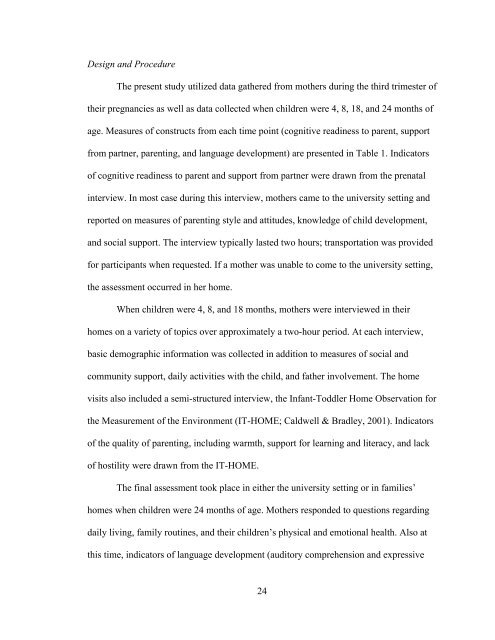DIFFERENCES BETWEEN ADOLESCENT AND ADULT MOTHERS ...
DIFFERENCES BETWEEN ADOLESCENT AND ADULT MOTHERS ...
DIFFERENCES BETWEEN ADOLESCENT AND ADULT MOTHERS ...
Create successful ePaper yourself
Turn your PDF publications into a flip-book with our unique Google optimized e-Paper software.
Design and Procedure<br />
The present study utilized data gathered from mothers during the third trimester of<br />
their pregnancies as well as data collected when children were 4, 8, 18, and 24 months of<br />
age. Measures of constructs from each time point (cognitive readiness to parent, support<br />
from partner, parenting, and language development) are presented in Table 1. Indicators<br />
of cognitive readiness to parent and support from partner were drawn from the prenatal<br />
interview. In most case during this interview, mothers came to the university setting and<br />
reported on measures of parenting style and attitudes, knowledge of child development,<br />
and social support. The interview typically lasted two hours; transportation was provided<br />
for participants when requested. If a mother was unable to come to the university setting,<br />
the assessment occurred in her home.<br />
When children were 4, 8, and 18 months, mothers were interviewed in their<br />
homes on a variety of topics over approximately a two-hour period. At each interview,<br />
basic demographic information was collected in addition to measures of social and<br />
community support, daily activities with the child, and father involvement. The home<br />
visits also included a semi-structured interview, the Infant-Toddler Home Observation for<br />
the Measurement of the Environment (IT-HOME; Caldwell & Bradley, 2001). Indicators<br />
of the quality of parenting, including warmth, support for learning and literacy, and lack<br />
of hostility were drawn from the IT-HOME.<br />
The final assessment took place in either the university setting or in families’<br />
homes when children were 24 months of age. Mothers responded to questions regarding<br />
daily living, family routines, and their children’s physical and emotional health. Also at<br />
this time, indicators of language development (auditory comprehension and expressive<br />
24
















